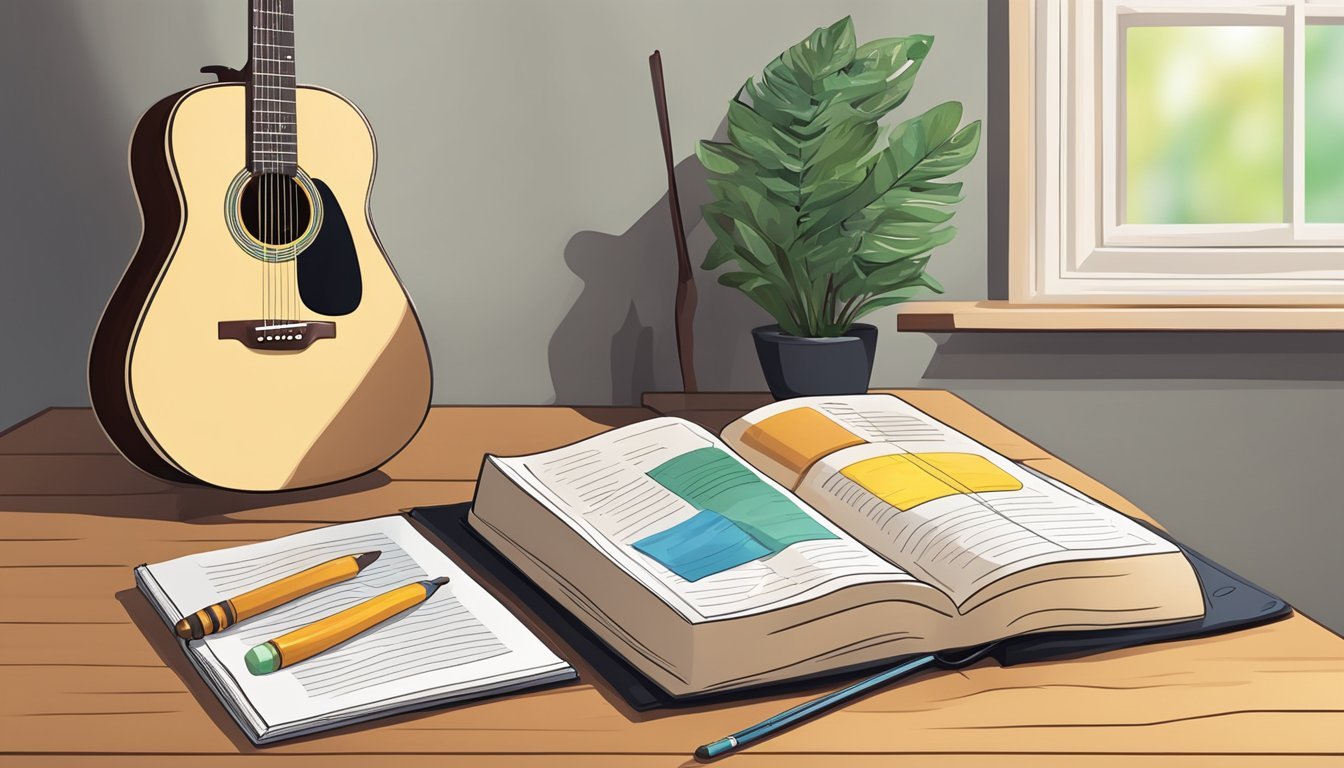Playing acoustic guitar is a rewarding and enjoyable journey that anyone can start, no matter your age or background.
To begin, familiarize yourself with your guitar, learn some basic techniques, and start with simple chords and strumming patterns.
This approach not only builds your confidence but also gets you playing songs you love in no time.

With the right mindset and consistent practice, you will discover that learning guitar can be a fun experience.
Start with short practice sessions, and gradually increase the time as you become more comfortable.
You’ll find that each small step you take gets you closer to playing like a pro.
So, grab your acoustic guitar and let’s dive into the essentials of getting started on your musical adventure!
Key Takeaways
- Know your guitar and its parts for a solid foundation.
- Start with simple chords and techniques to build skills.
- Regular practice is key to progress and improvement.
Getting to Know Your Guitar
Understanding your guitar is key to getting started.
Familiarizing yourself with its parts, how to hold it, and how to tune it will make playing more enjoyable.
Let’s dive into the essential aspects of your acoustic guitar.
Parts of the Guitar
Your guitar has several key parts that work together to create sound.
Here are the most important:
- Body: The large part you see. It amplifies the sound.
- Fretboard: This is where you place your fingers to play notes and chords. It has metal strips called frets.
- Headstock: Located at the top of the guitar, it holds the tuning pegs.
- Machine Heads: These are the tuners on the headstock that you use to adjust the tension of the strings.
- Strings: Most acoustic guitars have six strings that create sound when plucked or strummed.
Getting to know these parts helps you understand how to handle your guitar better.
Holding Your Guitar
How you hold your guitar affects your comfort and ability to play.
When seated, keep the body of the guitar resting on your right leg, if you’re right-handed.
Use a guitar strap if you’re standing.
This keeps the guitar secure and lets you move freely.
Position the neck slightly away from your body for easier access to the fretboard.
Make sure your hands are relaxed.
Tension can hinder your playing.
Place your left hand on the neck and your right hand over the body to strum or pick.
Find a position that feels natural to you.
Tuning Your Guitar
Tuning is essential for good sound.
Use a tuner or a tuning app to help you.
The standard tuning for an acoustic guitar from the thickest to the thinnest string is E, A, D, G, B, and E.
Start with the lowest string, E, and check it against the tuner.
If it sounds off, adjust the corresponding machine head until it matches.
Repeat this for the remaining strings.
Always remember to check your tuning regularly, especially before playing.
A well-tuned guitar is much more fun to play!
Basic Guitar Techniques
Getting comfortable with a few basic techniques will make your journey in learning acoustic guitar much easier and more enjoyable.
You’ll focus on finger placement, strumming, and using a guitar pick, all essential skills for beginners.
Finger Placement and Chords
Proper finger placement helps produce clear sounds and makes transitioning between chords smoother.
Start with easy chords like G, C, and D. These basic chords form the foundation for many songs.
When pressing down on a string, use your fingertips.
This keeps your fingers from unintentionally muting other strings.
Aim to place your fingers just behind the fret for the best sound.
Consult a chord chart to visualize finger positions and practice switching between chords.
Regular practice will build muscle memory, making it easier to play more complex chords in the future.
Strumming and Patterns
Strumming is key to keeping rhythm and making your playing sound musical.
Start with basic downstrokes, where you brush downward across the strings.
Once comfortable, try combining downstrokes and upstrokes for variation.
Simple strumming patterns, like D-DU-UDU (D = down, U = up), can add texture to your playing.
Practice these patterns slowly at first.
Gradually increase speed as you feel more confident.
Mixing in different rhythms helps create your style.
Be sure to listen to songs you love and try to mimic their strumming patterns to develop your ear.
Using a Guitar Pick
If you choose to use a guitar pick, grip it firmly but not too tight.
Your thumb and index finger should hold it with the pointed end sticking out.
This allows for better control and strumming accuracy.
Practice strumming with the pick while keeping a relaxed hand.
You can also try fingerpicking, which uses your fingers instead of a pick.
Each method produces a different sound, so experiment to see what you like best.
Remember to develop your own comfortable style.
Whether with a pick or your fingers, consistent practice will help you improve and enjoy playing more.
First Guitar Lessons
Starting your journey on the acoustic guitar means learning a few essential skills.
You’ll want to focus on basic chords first, then move on to playing simple songs that integrate those chords.
This approach keeps things fun and achievable.
Learning Basic Chords
To play the guitar, knowing a few basic chords is crucial.
Begin with simple chords like C, G, D, and E minor.
These are easy to finger, and they sound great together.
Here’s a quick list of simple chords to practice:
- C Major: Place your ring finger on the 3rd fret of the A string.
- G Major: Place your middle finger on the 3rd fret of the E string.
- D Major: Use your index finger, middle finger, and ring finger across the second fret.
Practice switching between these chords.
Use a metronome to keep time.
Strumming them in different combinations helps build muscle memory.
Being comfortable with these basic chords sets a solid foundation for your guitar playing.
Playing Simple Songs
Once you feel good with the basic chords, it’s time to play some songs! Start with well-known, easy songs that mainly use the chords you’ve learned.
Songs like “Knockin’ on Heaven’s Door” have simple chord progressions that are perfect for beginners.
Focus on:
- Listening to the song first to understand the rhythm.
- Strumming along slowly, matching your chords to the music.
Try to sing along as you play.
This helps you think about timing and transitions.
Learning simple songs keeps your practice engaging and enjoyable.
Plus, it’s rewarding to play along to your favorite tunes!
Practice Makes Perfect

When you’re starting to play acoustic guitar, practice is key.
Creating a solid practice routine helps build your skills and confidence.
Here’s how you can get started on the right track.
Developing a Practice Routine
To get the most out of your practice, try setting aside time each day.
Even short sessions of 15 to 30 minutes can make a big difference.
Consistency is important, so find a time that works best for you.
A good routine should include warm-ups, chord practice, and song work.
A simple way to break it down is:
- Warm-up (5 minutes): Start with finger exercises or simple scales.
- Chords (10 minutes): Practice switching between basic chords like G, C, and D.
- Songs (10-15 minutes): Choose a favorite song to work on. Focus on playing it slowly before speeding up.
Remember, it’s about quality over quantity.
Try to make each session focused and fun!
Frequently Asked Questions
You probably have some common questions about starting your journey with the acoustic guitar.
Here are some answers that can help guide you as you begin.
One of the first things you might wonder is where to start or what materials you need.
To effectively learn acoustic guitar basics, it’s essential to invest in a good quality instrument and find resources like online tutorials or books designed for beginners.
Additionally, practicing regularly and setting achievable goals will keep you motivated and help you build your skills over time.
Can you teach yourself to play the acoustic guitar?
Yes, you can definitely teach yourself.
Many people have learned to play the acoustic guitar on their own using online resources, tutorials, and practice.
It may take time and patience, but self-teaching is a rewarding path.
What’s the first thing I should learn when starting acoustic guitar?
Start with learning how to hold the guitar and tune it.
Once you’re comfortable, focus on basic chords like G, C, and D. These chords form the foundation for many songs and will help you get started.
Are acoustic guitars suitable for beginners?
Yes, acoustic guitars are great for beginners.
They are simple to use and do not require any extra equipment.
You can take them anywhere and start practicing right away.
What are the basic chords I should know as a beginner on the acoustic guitar?
As a beginner, focus on these basic chords: G, C, D, E, and A. These chords are commonly used in many songs.
Practicing them will help you play along with your favorite tunes.
How can I learn to play the acoustic guitar from scratch on my own?
You can learn by watching online videos, using apps, or following step-by-step guides.
Set aside regular practice time each week to build your skills gradually.
Start with simple songs that use the basic chords.
Where can I find beginner acoustic guitar lessons for free?
You can find free lessons on websites like YouTube or guitar-focused platforms.
Many sites provide tutorials specifically geared towards beginners.
These include chord lessons and strumming techniques.

